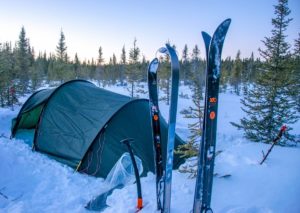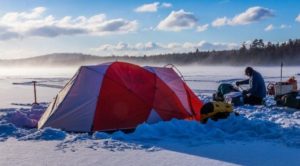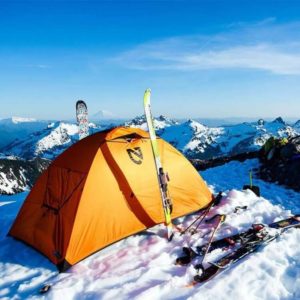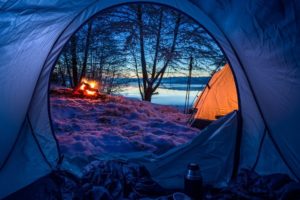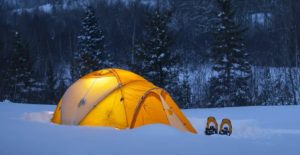Disclosure: this post may contain affiliate links. As an Amazon Associate we earn from qualifying purchases.
When you think of camping, you think of spending time and enjoying scenic views in the forests, the mountains, beach, and desert or just outside your house during summer. Have you ever thought what it is like to camp in places with constant cold temperatures or during winter?
There is some joy that comes with such experiences. Imagine waking up from your tent and finding snow has already covered the ground. All you would beg for is a cup of coffee to warm your body. As amazing and gorgeous the view would be, it’s extremely crazy to step out for fun activities in such temperatures. So, have you ever wondered what temperatures are too cold for camping?
Contents
What Temperature is too Cold for Camping?
Climate researchers have first-hand experience with this weather since their work involves camping in the Antarctic. This shows it is possible to camp under very low temperatures. Nevertheless, for extreme adventurers, it’s almost never too cold for any camping or fun activities but some temperatures are not recommended. For the wellbeing of our bodies.
Any temperatures below 20 degrees Fahrenheit are too cold for camping. It makes it worse if you have kids around. You need specialized clothing and camping essentials in order to withstand this type of weather. Extremely cold temperatures can limit your outdoor activities and ruin the fun.
Despite the temperatures being too cold for camping one can still manage if well planned with all the necessary gear.
Key Factors to Consider When Camping in Cold Temperatures
Choose a suitable location
The location where you choose to camp is crucial. A site with plenty of tree coverage is preferable because they are generally warm. You are assured of a warmth overnight compared to a mountainous place. Areas that are occupied with water bodies like lakes, beaches and mountain craters are generally colder.
There is usually a lot of breezes coming through without any shields. Bushy areas are a lifesaver for such activities. Do not place your tent or overland vehicle with a rooftop tent in open areas to prevent the flow of cold air within your surroundings. Actually, I would recommend using a rooftop tent during cold weather instead of placing a tent on the ground. Pre-warming the vehicle before sleeping can create a layer of warmth.
Choose a suitable tent
As you plan for your outdoor escapade, one thing that is of importance and should be given much consideration is a suitable tent. With cold temperatures you need to get the right tent. A suitable tent should be able to add about 10 degrees of warmth to the outside temperatures. You need a tent that will keep you warm and retain the heat at the same time providing the required lighting and ventilation. A good tent for such occasion needs to be insulated and should be able to keep out any precipitation.
Cold weather tents are specialized designed to be durable to withstand any strong winds and heavy snowfall. 4 season tents also known as winter tents are used all year round for all seasons. They are built to withstand harsh climatic conditions. The fabric that is used to make them is insulated and strong.
The tents have very strong pole and steeper sides to keep the tent intact and steady on the ground. It also prevents collapsing of the tent roof from snow collecting on top. It’s the best protection tent for cold seasons. With this type of tent you might be tempted to prolong your stay thus won’t be in a hurry to go home. Other factors to consider when choosing a specialized tent for cold temperatures are:
Getting double wall tent – Double wall tents are warmer with a rainfly. However they are heavier compared to single wall tents
- Nylon or polyester tent – Purchase a tent that is made of nylon material, it’s durable and long-lasting. Polyester is also recommended because of its waterproofing abilities and provides good sun protection.
- A tent with a vestibule or small pocket like spaces at the front or sides can be helpful in storing wet gears.
Based on my personal camping experience in cold areas and seasons, I recommend the a double wall 4 season tent. I use the Nemo Kunai Tent and it performs very well in my skiing, basecamping, treeline, and light mountaineering expeditions.
Proper Clothing
Adequate and suitable warm clothes are necessary for cold temperatures. When you decide to go to venture in less than 20 degrees F temperatures, ensure to have a solid budget for buying appropriate gears. You will need to layer up with very warm clothing from top to bottom. Wool and heavy cotton clothes are the best for this type of weather. The type of clothes that you might need to assist in generating natural heat are as follows.
- Long sleeve shirts
- Sweaters or Jumpers
- Pajamas
- Jeans
- Leg warmers
- Socks
Depending on the amount of wind, you might need something to cover your head and ears. A cap or marvin and ear muffs will come in handy. Woolen scarf will cover your neck and nose to prevent any frostbites. You also require gloves for your hands not to freeze.
Selecting appropriate sleeping gears
Of course, camping involves sleeping outside the comfort of your bed at home. The first thing you will think of locking in enough heat in the tent and where you are going to rest for the night. You will definitely need a sleeping bag, and a warm sleeping pad or camping mattress.
It is highly recommended to go with a sleeping bag instead of a plain blanket or duvet or sheets because sleeping bags tend to retain more heat. Place a pad or a mattress as a bottom layer with a thick comforter. Then insulate your sleeping bag with clothes or add a hot water bottle to retain more heat.
Always have a duvet or blanket on top for an additional cover. As you layer up and set your sleeping gears, remember not to overdo it to avoid sweating a lot through the night.
Most good sleeping bags use the EN 13537 rating system. This rating is determined by putting a heated manikin into the sleeping bag. There are sensors on the manikin which determine temperature. This is a good sleeping bag to explore for your expedition.
Stove and Fuel
Hot meals are important to keep your body warm. In cold temperatures, your body usually works extra hard to generate heat. Having a cup of coffee will greatly help. You need to have the carry the right stove.
Preparing meals during camping settings is not as easy as home. You need extra effort and reliable equipment. All-in-one canister stoves are the easiest to use, and the MSR WindBurner in particular.
After lighting the stove and snapping everything into place, the enclosed burner brings water to a boil quickly, even in gusty conditions. Alternatively, you can opt for a liquid-fuel stove, which has a fuel line that connects to a separate refillable bottle (most often white gas), but is heavier and slower to set up.
Must Have Essentials for Camping in Cold Temperatures
1. Winter camping equipment
- 4-Season Tent (Nemo Kunai)
- Cold-Weather Sleeping Bag
- Insulated Sleeping Pad
- Medium Duvet
- Stove and Fuel
- Stove Platform
- Utensils and Cookware
- Headlamp
2. Cold-weather clothing
- Winter Jacket
- Hardshell Jacket
- Hardshell/Softshell Pants
- Baselayers
- Midlayer
- Gloves
- Hat(s)
- Warm Socks
- Sunglasses or Goggles
3. Winter travel and avalanche safety gear
- Backcountry Skis or Snowshoes
- Backcountry Ski Boots or Mountaineering Boots
- Backpack or Sled
- Poles
- Navigation
- Beacon
- Probe
- Shovel
4. Other Essential Camping Item’s Checklist
- Sufficient Food
- Water Bottles
- Thermos
- First Aid Kit
- Booties
- Gaiters
- Camera
- Sunscreen and Lip Balm
- Balaclava or Neck Gaiter
- Personal Hygiene Items
- Lighters or Waterproof Matches
- Knife or Multi-Tool
- Crampons
- Ice Axe
Tips and Tricks for Camping in Extremely Cold Temperatures
Some tips and tricks to make sure your stay warm inside your tent when the temperatures are too cold for camping
- Don’t wait until you’re already cold to add a layer, as soon as the temperature drops in the evening add something to keep you warm.
- Don’t go to bed cold, sleeping bags are hard to warm up if your body temperature is already low. Do some star jumps or walk around your tent to warm up before getting in.
- Disposable heat pads are great for emergency use- take a few along for those nights when you just can’t get warm.
- A big tent containing just a few people will be much colder than a smaller tent. Make sure you have enough room but no excess air to warm up.
- Layer up your sleeping pads to provide extra insulation from the ground and add a blanket underneath your sleeping bag if you’re still cold.
- Wear a hat in bed. If you just can’t seem to warm up despite trying everything else, wearing a hat will help retain body heat.
- Don’t put your head into your sleeping bag or breathe into your bag to try and warm it up. All you’ll do is create condensation which can result in a damp sleeping bag and low body temperature. The same goes for if you start to sweat, take some layers off to cool down.
- Make sure your tent is well ventilated throughout the night. This reduces the risk of condensation.
- Drink plenty of fluids. Make sure you’re drinking plenty of water throughout the day because it’s easy to become dehydrated during the winter months due to the lack of humidity in the air. You need to replace the water you’re losing through respiration, elimination and evaporation.
- Food. Breakfast should be a simple but nourishing meal, packed full of calories to keep you going until lunchtime. Porridge, dried fruit, nuts and eggs are all great breakfast options. Snack throughout the day on foods like nuts, cheese, dark chocolate and dried fruit. For dinner time something fast and hot is a great idea as you’ll be sat still and getting cold quickly. Something rich in complex carbohydrates like wholegrain pasta is a good start. Eating something rich in fat calories around an hour before you go to sleep will help you stay warm throughout the night- especially if you had an early dinner.
Conclusion
I hope I answered your question on what temperature is too cold for camping. Camping in any temperatures below 20 degrees Fahrenheit is not easy and a challenge to most people. However, as you have seen above, it is not impossible.
One should generally avoid camping in extremely cold temperatures. However, with proper planning and right gear such as a four-season (rooftop) tent, sleeping bag, heavy clothes, nutritious food, and other aforementioned essentials it is very possible.
It is also adventurous to camp in cold temperatures especially during winter and snow. It is a totally different experience compared to camping during other seasons.
Brace up and have a safe and enjoyable camping in cold temperatures. Remember to make a snow man with a carrot for the nose ????
Amazon and the Amazon logo are trademarks of Amazon.com, Inc, or its affiliates.

